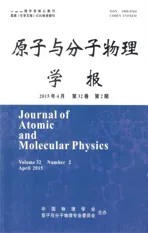耗散环境下二比特体系的量子关联性质研究
2015-03-23杨国晖
李 磊, 杨国晖
(山西师范大学物理与信息工程学院, 临汾041000)
耗散环境下二比特体系的量子关联性质研究
李 磊, 杨国晖
(山西师范大学物理与信息工程学院, 临汾041000)
利用Quantum Discord(QD) 判据,研究了与热库相互作用的二比特体系的量子关联性质.讨论了在不同初态下体系量子关联随时间的变化,以及热库的平均光子数m,n和原子的自发辐射率γ对体系量子关联性质的影响.结果表明,在不同的初态下,体系可以得到不同性质的量子关联;而且当原子自发辐射率γ取固定值时,QD的衰减会随m,n取值的减小而减慢,热库平均光子数都为零的情况下能够得到最大范围的量子关联;此外,当热库平均光子数m,n取确定值时,随着γ取值的减小,QD的衰减也会随之减慢,此时同样会得到较大范围的量子关联.说明较小的热库平均光子数以及原子自发辐射率γ能够减弱QD的衰减,从而获得生命力较强的体系量子关联.
量子关联;QuantumDiscord; 二比特体系; 耗散环境
1 引 言
量子关联作为量子信息中的重要资源直接影响量子信息处理的效率与可靠信,它被广泛地应用于量子通信和量子计算[1]. Quantum Discord(QD)[2]作为量子关联的一种度量方式被广泛地应用于二比特量子态的量子关联度量. 最近的研究结果[3,4]表明Quantum Discord比量子纠缠能够更普遍地描述非经典的关联,比如说在一些混合态中,纠缠值为0的时候可以得到非零的QD的值,从而证实了非经典关联的存在.另一方面,在现实的量子体系中,不可避免地会与环境相作用[5,6],因此与环境相互作用的关联以及开放的量子体系具有了可观的研究前景[7-9],量子体系和环境的相互作用常常导致了退相干过程[10-12]. 一个典型的例子就是自由空间中两个距离很近的可分离二能级原子的自发辐射纠缠态.受激原子与周围环境发生相互作用引起的自发辐射是主要的退相干资源之一,而且被认为是量子关联在实际应用中的主要障碍.
本文研究在耗散环境下二比特体系的量子关联性质.讨论了在不同初态下Quantum Discord(QD)随时间t的变化情况,以及热库平均光量子数m,n和原子自发辐射率γ对体系量子关联的影响.
2 模型和方法
考虑两个二能级原子单独地与热库相耦合,两个原子之间没有相互作用.体系动力学所满足的密度矩阵表示为
(1)

QuantumDiscord(QD): 在经典信息理论中,一个二比特量子体系总的量子关联可以使用总量子互信息I(ρAB)来描述,互信息I(ρAB)定义为
I(ρAB)=S(ρA)+S(ρB)-S(ρAB)
(2)
这里,S(ρ)=-Tr(ρlog2ρ)是密度矩阵的冯诺依曼熵,ρA和ρB分别表示约化密度矩阵的子系统A和子系统B.量子互信息常常作为总关联的一种度量方式,它既包含量子关联也包含经典关联.经典的关联C(ρAB)被定义为一个子系统ρi的最大信息,它依赖于另外一个子系统的测量.我们选择一种测量方式,它被局域作用在子系统B上的一组投影算符Πk=|k>
(3)

D(ρAB)=I(ρAB)-C(ρAB)
(4)
这个式子就被定义为QuantumDiscord(QD).一般情况下QD往往是较难计算的,然而对于X结构的密度矩阵来说,如果我们定义
(5)
λi是密度矩阵ρAB的本征值,然后就得到了X结构密度矩阵的量子Discord表达式[13]
D(ρAB)=min(Q1,Q2)
(6)
这里,D1=H(τ) 和D2=-Σiρiilog2ρii-H(ρ11+ρ33),而且
H(τ)=-τlog2τ-(1-τ)log2(1-τ)
τ=(1+
3 结果与讨论
由体系密度矩阵所满足的表达式(1)和QuantumDiscord的定义,我们讨论体系在不同初态的量子关联动力学性质.


(7)
其中,


图1 QD随时间t的变化,图(a)图 (b)中原子自发辐射率γ分别为1和0.15,参数m的取值都为0.1Fig.1 QD versus time t for fixed spontaneous emission rate γ,γ equals 1(plot a) and 0.15 (plot b),for all plots m=0.1



(8)



图2 QD随系统温度T的变化,图(a)和图(b)中自发辐射率γ分别为1和0.1,参数n的取值都为0.1Fig.2 QD versus temperature T for fixed spontaneous emission rate γ,γ equals 1(plot a) and 0.1(plot b),for all plots n=0.1
(9)
其中,b1=(2mnc+3mc/2+3nc/2-m/2-n/2-mn+c)e-2γt(m+n+1),
接下来讨论体系在此初态下的量子关联性质.

图3 QD随时间t和参数c的 变化, 参数γ=1,(m=0.9, n=0.3 (图a)),(m=n=0(图b))Fig.3 QD versus time t and parameter c for fixed spontaneous emission rate γ,(m=0.9,n=0.3(plot a)) and (m=n=0 (plot b)),for all plots γ=1
(10)
其中,


图4 QD随系统时间t的变化,图(a)图(b)中原子自发辐射率γ分别为 1 和 0.2
4 结 语

[1]NielsenMA,ChuangIL.QuantumcomputationandQuantuminformation[M]. Cambridg: Cambridge University Press, 1998.
[2] Ollivier H, Zurek W H. Quantum discord: A measure of the quantumness of correlations [J].Phys.Rev.Lett., 2001, 88: 017901.
[3] Dakic B, Vedral V, Brukner C. Necessary and sufficient condition for nonzero quantum discord [J].Phys.Rev.Lett., 2010, 105: 190502.
[4] Chen L, Chitambar E, Modi K,etal. Detecting multipartite classical states and their resemblances [J].Phys.Rev. A, 2011, 83: 020101.
[5] Zurek W H. Decoherence, einselection, and the quantum origins of the classical [J].Rev.Mod.Phys., 2003, 75: 715.
[6] Mi Y J. Classical correlation and quantum discord in a two qubit system under dissipation environments [J].InternationalJournalofTheoreticalPhysics, 2012, 51(2): 544.
[7] Plenio M B, Huelga S F, Beige A,etal. Cavity loss induced generation of entangled atoms [J].Phys.Rev. A, 1999, 59: 2468.
[8] Ficek Z, Tanas R. Dark periods and revivals of entanglement in a two-qubit system [J].Phys.Rev. A,2006, 74: 024304.
[9] Fabio, Roberto F, Marco P. Environment induced entanglement in markovian dissipative dynamics[J].Phys.Rev.Lett., 2003, 91: 070402.
[10] Quan H T, Song Z, Liu X F,etal. Decay of Loschmidt echo enhanced by quantum criticality [J].Phys.Rev.Lett., 2006, 96: 140604.
[11] Ikram M, Li F L, Zubairy M S. Disentanglement in a two-qubit system subjected to dissipation environments [J].Phys.Rev. A, 2007, 75: 062336.
[12] Guo J L, Song H S. Entanglement and teleportation through a two-qubit Heisenberg XXZ model with the Dzyaloshinskii-Moriya interaction [J].Eur.Phys.J.D, 2010, 61: 791.
[13] Wang C Z, Li C X, Nie L Y,etal. Classical correlation and quantum discord mediated by cavity in two coupled qubits [J].J.Phys. B:At.Mol.Opt.Phys., 2011, 44: 015503.
Quantum correlation dynamics in a two qubit system under dissipation environments
LI Lei, YANG Guo-Hui
(College of Physics and Informatien Engineering, Shanxi Normal University, Linfen 041000, China)
Using the Quantum Discord(QD) criterion, we study the quantum correlation dynamics of two-qubit system interacted with the thermal reservoir. We discussed the correlation properties under the different initial states with time, and the influences of the mean photon numbers and the spontaneous emission rate on the quantum correlations. The results show that different initial states can lead to different effects of correlation dynamics. And when the spontaneous emission rateγisfixed,thedecaysofQDisslowerwithsmallervalueofthemeanphotonnumbers,whenthemeanphotonnumbersarezero,itcanobtainthemaximalregionofQD.Moreover,whenthemeanphotonnumbersarefixed,thedecaysofQDisslowerwithsmallervalueofγ,italsocanobtainthelargerregionofQD.Thatistosay,smallervalueofthemeanphotonnumbersandthespontaneousemissionrateγcanmakethedecaysofquantumcorrelationslower,anditcanobtainastrongerlifeofthequantumcorrelation.
Quantum correlation; Quantum discord; Two qubit system; Dissipation environment
103969/j.issn.1000-0364.2015.02.018
2013-11-14
国家自然科学基金(11247247);山西省青年科技研究基金(2012021003-3)
李磊 (1988—),男,山西朔州人,硕士,研究方向为量子信息与量子计算.E-mail: LiLei729@126.com
杨国晖.E-mail: yangguohui-1981-1981@126.com
O
A
